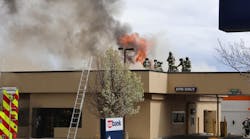One of the continuing difficulties crews encounter when rolling a dash has turned out to be creating and maintaining a suitable anchor point along the rocker channel. This push point must be strong and solid enough to resist the forces of the base of the pushing tool. Modern vehicles seem to be missing anything solid or thick along their rockers anymore. The base of the rocker and B-pillar used to be a great pushing point for this assignment until the "three-door" design came into being. Now, with the front door and a rear-hinged, rear door open, there may not even be a B-pillar at all. The distance from the base of the C-pillar to the push point on the A-pillar of a Chevrolet Silverado 1500 three-door pickup truck is 58 inches, a distance beyond the reach of most power rams.
This column reviews a series of options rescuers have for establishing a sufficient anchor point for pushing the dash and firewall forward during a dash roll evolution.
When rolling a dash was first introduced to rescue teams, the original anchor point was always the base of the B-pillar. To improve upon this, most fire departments with power rams also either bought or built some sort of ram support plate; an L-shaped bracket that reinforces the base of the rocker channel during the dash roll. By far, the most versatile of the manufactured ram support tools are the O'Connell Plates from Rescue 42. Go to www.rescue42.com for more information on this accessory tool.
Positioning the ram support at the junction of the rocker and B-pillar allows the dash roll to take place while the reinforced rocker holds its ground. If the entire rocker moves downward, cribbing placed under the rocker will strengthen the vehicle as the dash moves.
When the B-pillar has been damaged or cut off during a previous assignment, securing a base point becomes a bit more challenging. One option is to drive the point of a Halligan bar into the rocker. The pushing tool pushes against the Halligan.Clamping is another option to hold an anchor point in place during the push. A piece of two-by-four-inch cribbing can be held in place by being squeezed with a power spreader. The spreader clamps the wood a few inches from the end of the cribbing. The pushing tool set against the end of the wood block to roll the dash forward.
The most common clamping option that fire departments use is clamping the rocker with a power spreader. This is not always a safe or effective procedure. Only a select few manufacturers of power rescue systems endorse "squeezing" with their spreader. Generally, it takes a fat-arm spreader to be able to resist the high side torsional forces that can easily damage the spreader arms in this manner. A narrow-arm spreader is very susceptible to being damaged when squeezing the rocker channel during a dash roll. A homemade accessory for a power spreader (we'll call it the Utah Tool) is designed specifically to squeeze a rocker. The Utah Tool actually is fitted to one spreader arm with a locking pin. Once in place, it creates an anchor point to each side of the spreader's arms.
The most sophisticated and by far the most versatile professionally manufactured device for obtaining an anchor point for rolling a dash is a relatively new tool known as the TarHeel. Designed and manufactured by a Virginia-based rescue tool dealer, the tool operates hydraulically to clamp onto the rocker channel.
As the manual pump is operated to 7,000 psi, the anodized aircraft aluminum TarHeel closes to clamp onto the rocker with over 6,000 pounds of force. Two stainless steel L-shaped plates on each side of the TarHeel hydraulic ram create anchor points for tasks such as rolling a dash. The uniqueness of the clamping action of the TarHeel also allows it to be used for stabilization and anytime a secure anchor point is needed. Information about this tool is available through the manufacturer's website at www.thetarheel.com.
TASK: Given an acquired vehicle and department extrication equipment, demonstrate at least three different procedures for creating an anchor point sufficient to allow a pushing tool to roll a dash away from a simulated patient trapped in the front seat of a vehicle.














